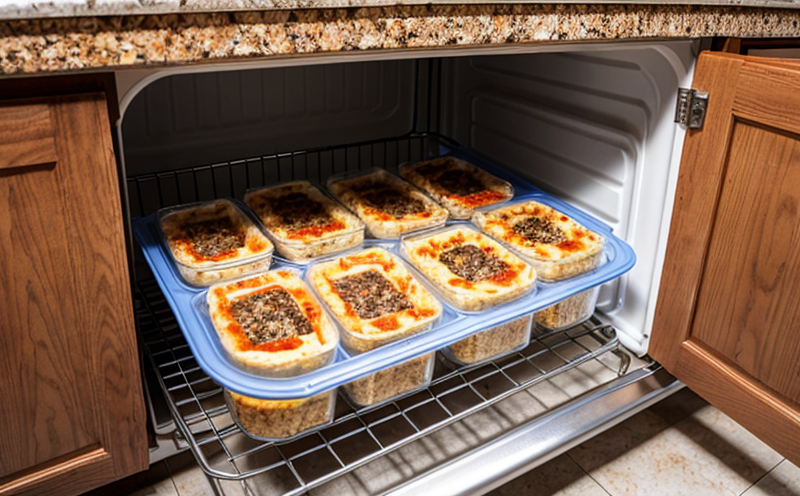Cooked food storage inspection
Properly stored cooked food is a cornerstone of safe and hygienic food handling practices. The storage conditions directly influence the quality, safety, and shelf life of prepared meals. This section focuses on ensuring that cooked foods are stored under optimal conditions to prevent contamination and deterioration. In the context of food safety and hygiene inspection, this service plays an essential role in maintaining public health by minimizing the risk of foodborne illnesses.
The process begins with understanding the temperature and time parameters required for safe storage. According to FDA guidelines, cooked foods should be cooled rapidly to 7°C (45°F) within two hours, followed by further cooling to 3°C (45°F) or below within four hours. This is known as the "Danger Zone," where bacteria can multiply quickly.
Our laboratory uses advanced techniques and equipment such as ASTM E2187 for thermocouple calibration to ensure that our storage chambers operate within the specified temperature ranges. We also employ real-time data logging systems to monitor temperatures continuously, providing detailed logs that can be used during audits or when troubleshooting issues.
The inspection process involves several critical steps:
- Temperature Monitoring: Ensuring that all storage areas are maintained at the correct temperature is paramount. Our laboratories use ISO 9372 to calibrate our thermometers and ensure accuracy.
- Time Monitoring: The time spent in the "Danger Zone" must be minimized. We employ continuous monitoring systems that alert us when temperatures deviate from the set parameters, allowing immediate corrective action.
- Humidity Control: Proper humidity levels are critical to prevent moisture-related spoilage and mold growth. Our laboratories use ISO 9237 for relative humidity calibration, ensuring that all storage areas meet the required standards.
- Cross-Contamination Prevention: We ensure that cooked foods are stored away from raw ingredients and other potential contaminants. This is critical to prevent cross-contamination which can lead to foodborne illnesses.
The results of our inspections provide comprehensive reports detailing the compliance levels with relevant standards and guidelines. These reports are invaluable for quality managers, compliance officers, and R&D engineers in ensuring that their facilities meet the highest safety and hygiene standards.
Quality and Reliability Assurance
The integrity of cooked food storage is not only about meeting regulatory requirements but also ensuring reliability and consistency. Our laboratory adheres to strict quality assurance protocols, which are crucial for maintaining customer trust and compliance with international standards.
- Calibration: We calibrate all our equipment against recognized international standards such as ISO 9372 and ISO 9237. This ensures that all measurements are accurate and consistent.
- Data Logging: Continuous data logging is a key component of our quality assurance processes. This allows us to track temperature, humidity, and other critical parameters in real-time, providing detailed records for each inspection.
- Validation: We validate all storage chambers against ISO 9373 to ensure that they meet the necessary performance criteria. This includes testing under various conditions to ensure reliability and consistency.
- Audits: Regular audits are conducted to ensure compliance with all relevant standards and guidelines. These audits help identify any areas for improvement and maintain high levels of quality assurance.
The reliability of our services is further enhanced by our experienced team of professionals who have extensive experience in the food safety sector. They stay updated on the latest industry trends, regulatory changes, and best practices to ensure that we provide the most accurate and reliable inspections possible.
Environmental and Sustainability Contributions
The impact of cooked food storage extends beyond just ensuring quality and safety; it also has environmental implications. Our laboratory actively contributes to sustainability efforts by minimizing waste, reducing energy consumption, and promoting eco-friendly practices.
We use energy-efficient equipment and systems that comply with ISO 20309 for energy efficiency. This not only reduces our environmental footprint but also helps clients meet their sustainability goals. By minimizing waste, we ensure that resources are used efficiently and effectively.
In addition to these measures, we provide advice on sustainable storage practices that can be implemented in food facilities. These include optimizing storage space, reducing the use of single-use materials, and promoting recycling. Our goal is to help clients create a more environmentally responsible supply chain.
Competitive Advantage and Market Impact
Adhering to strict quality and hygiene standards in cooked food storage can provide significant competitive advantages for businesses operating in the food sector. By ensuring that all cooked foods are stored under optimal conditions, companies can enhance their reputation as providers of safe and high-quality products.
- Better Reputation: Maintaining a spotless record regarding food safety and hygiene can significantly improve a company's reputation. This is especially true in today’s highly scrutinized market where consumers are increasingly concerned about the quality and safety of the products they consume.
- Increase Customer Trust: Consumers trust brands that demonstrate a commitment to high standards of quality and safety. By providing comprehensive inspection reports, companies can build stronger relationships with their customers and increase customer loyalty.
- Potential for Expansion: A reputation for excellence in food safety and hygiene can open up new market opportunities. Companies that excel in this area may find themselves expanding into new regions or categories of products where such standards are important.
In the broader context, ensuring that cooked foods are stored correctly contributes to public health by reducing the incidence of foodborne illnesses. This not only benefits consumers but also has a positive impact on the overall economy by minimizing healthcare costs and lost productivity due to illness.





